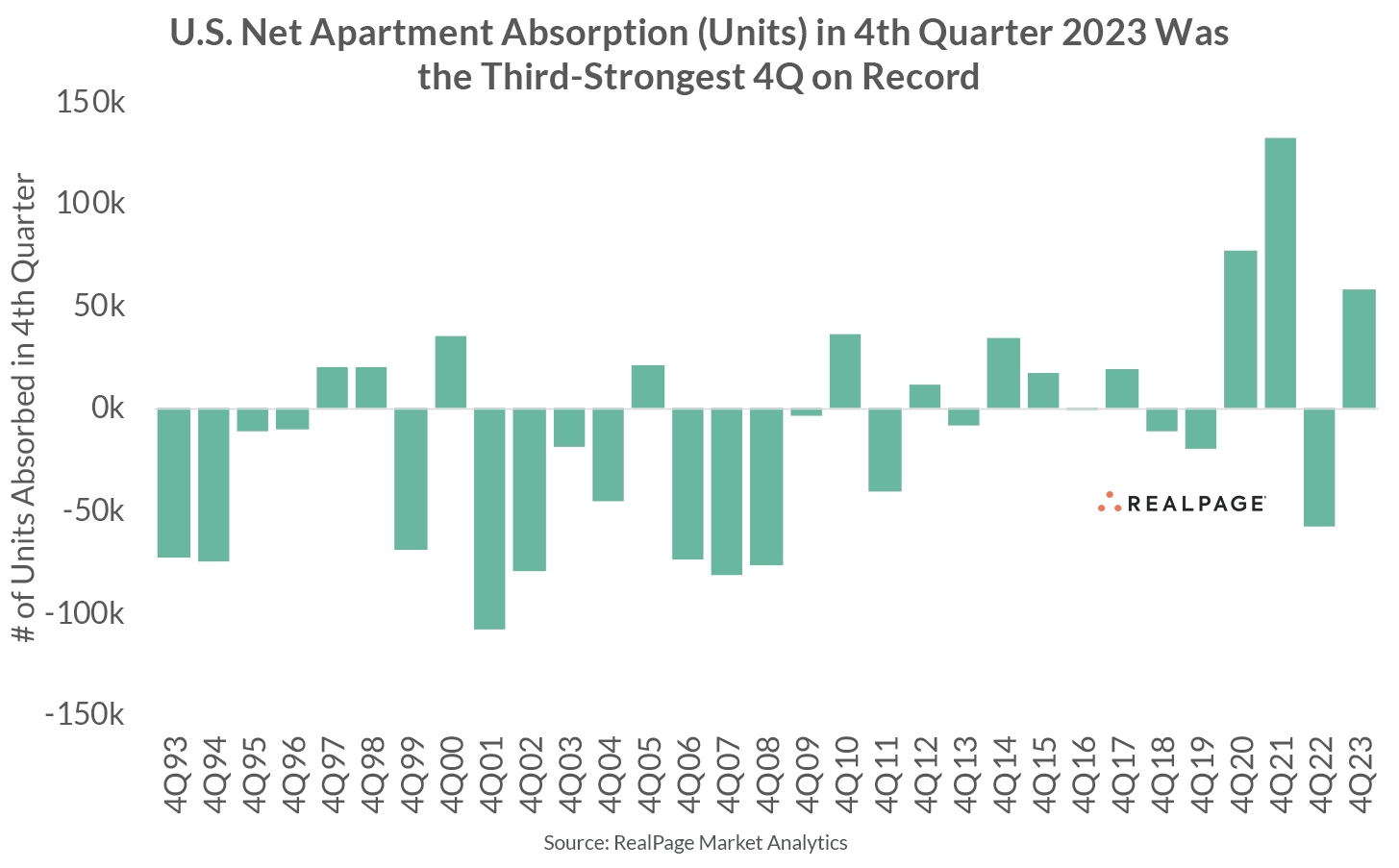Overall, the 2024 forecast calls for continued – albeit slowing – economic growth. Still, the improvement in demand throughout 2023 will likely carry forward into 2024 even with moderating economic growth. Demand should be boosted by strong wage growth and a prolonged renter lifecycle (i.e., less attrition to single family housing due to limited available inventory) among other factors. Supply will make the main deterrence for market-level rent growth and even rent growth at the national level. From that perspective, expect a close one-to-one relationship, where higher supply = weaker rent growth and lower supply = stronger rent growth. In lieu of rent growth, the things that will likely fuel much of the 2024 outlook will be focus on occupancy through means of modest new lease rent growth and increased emphasis on retention.
It’s difficult – if not altogether impossible – to point towards any larger influence in the coming 12 months than supply. Supply’s relationship on rent growth has been well-documented throughout 2023, and the impact of supply on rent growth is a clearly defined trend.
The good news is that this mounting wave of supply is being met with considerable improvement in absorption. After a tumultuous 2021 to 2022 stretch – two years that recorded both the strongest and weakest absorption figures in two decades – the 2023 pace of absorption seems to have stabilized. About 250,000 units were absorbed on net in 2023, more or less matching the U.S. average dating back to the 2010s.
Perhaps most impressive though was the strength of demand in 4th quarter 2023 in particular. The final 90 days of the year came in with the third-strongest absorption total for that quarter on record.
This very strong quarter seems to further indicate that not only has demand stabilized after a sluggish 2022 (and even a modest 1st quarter 2023), but that the nation’s ability to absorb a huge wave of supply in 2024 appears to be well-positioned.
The strength of demand may come as a surprise as the broader economic narrative would seemingly push the idea that the economy is slowing rapidly. While traditional economic growth metrics such as job growth do indeed show the pace of growth is moderating, it’s worth noting that job growth remains relatively strong.
Perhaps more important though is the recent strength of wage growth. Wage growth remains very strong and has historically been a strong predictor of household formation. With wage growth outpacing rent growth today – and further, to the degree that this has inverted – that should signal the potential release of more demand in 2024.
Turning towards rent growth, the market saw rent expansion slow considerably throughout 2023. Rent growth in the year-ending 2023 came in at 0.2%, well below the long-term norm. Still, monthly annualized rent growth shows that the market is actually improving in terms of rent growth. After bottoming out at 0.1% in August and September 2023, the December annualized rent growth reading of 0.3% shows that there has been ever-so-modest upwards movement in rent growth momentum.
With that in mind, it’s likely that 2024 sees modest-at-best rent growth. The general absence of rent growth going into 2024 can also been viewed through the lens of occupancy preservation. There has been a growing shift towards focusing on maintaining “heads on beds” throughout 2023 in anticipation of the huge wave of supply delivering in 2024. The continued focus of occupancy preservation will likely remain a key theme throughout 2024 for operators across the country.
Though the national expectation is that rent growth is modest in an effort to hold occupancy rates stable, there is also the expectation that market-level variations may be quite large. This once more stems from the supply pressure many markets will see in 2024.
This is especially important to note when comparing regional takeaways for 2024. The Midwest region is expected to see stronger rent growth than its West, South, and Northeast region counterparts. But this isn’t due necessarily to the strength of demand in the Midwest. Rather, limited supply should help keep rent growth afloat as even modest demand will be enough to fill the relatively small number of units delivering. Chicago, Cincinnati, Milwaukee, Cleveland, Columbus, Indianapolis, and Kansas City feature as expected top 10 performing markets in 2024.
The Northeast meanwhile follows a similar trend with decent demand and limited supply. As such, markets like New York, Pittsburgh, and Philadelphia are expected to slightly outperform the national average. Philadelphia should, however, be seen as a market where localized variations (i.e. low supply suburbs vs. the high supply urban core) will likely be very pronounced.
Within the South region, there is a split between lower supply markets (e.g. Baltimore, Virginia Beach, Richmond, Greensboro, and Memphis) and higher supply markets (Nashville, Charlotte, DFW, Tampa, Orlando, Austin). The latter will almost certainly see much stronger demand, though the pace of supply delivering will comfortably outpace demand in turn affecting rent growth. Still, the 2025-and-beyond outlook largely favors these fast-growth markets due to tapering multifamily starts and continued economic growth.
Finally, the West region sees a wide range of outcomes. On one hand, the West region was arguably the nation’s one exception when it came to the stabilizing demand story of 2023. The West region made up just 19% of the nation’s demand total despite comprising about 28% of the existing apartment stock. Phoenix, Denver and Seattle boasted quite strong absorption figures, though local rent growth in some of these markets remains challenged due to supply pressure. Conversely, demand in Northern California and Portland remains stagnant and could remain a challenge going into 2024.












